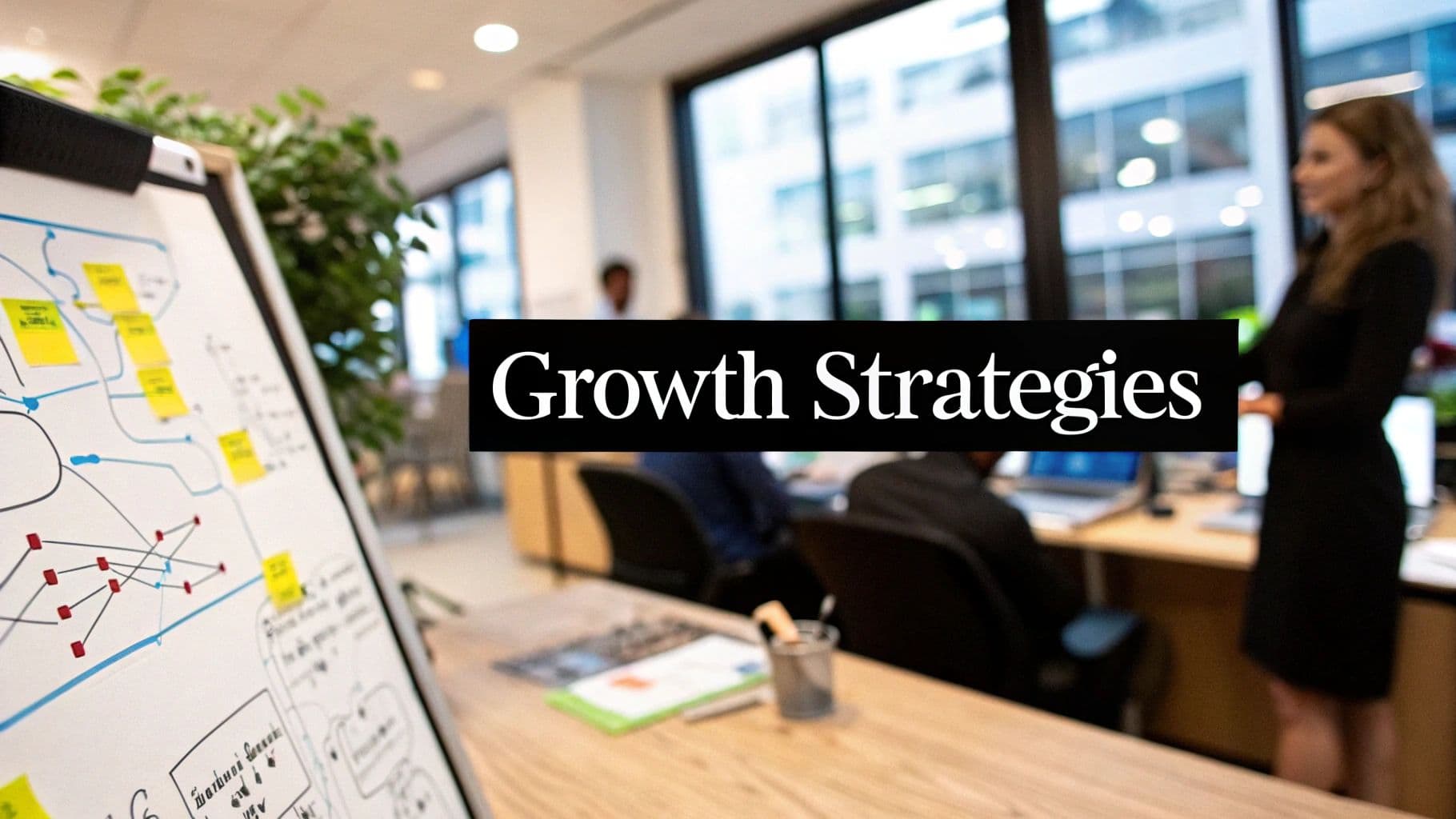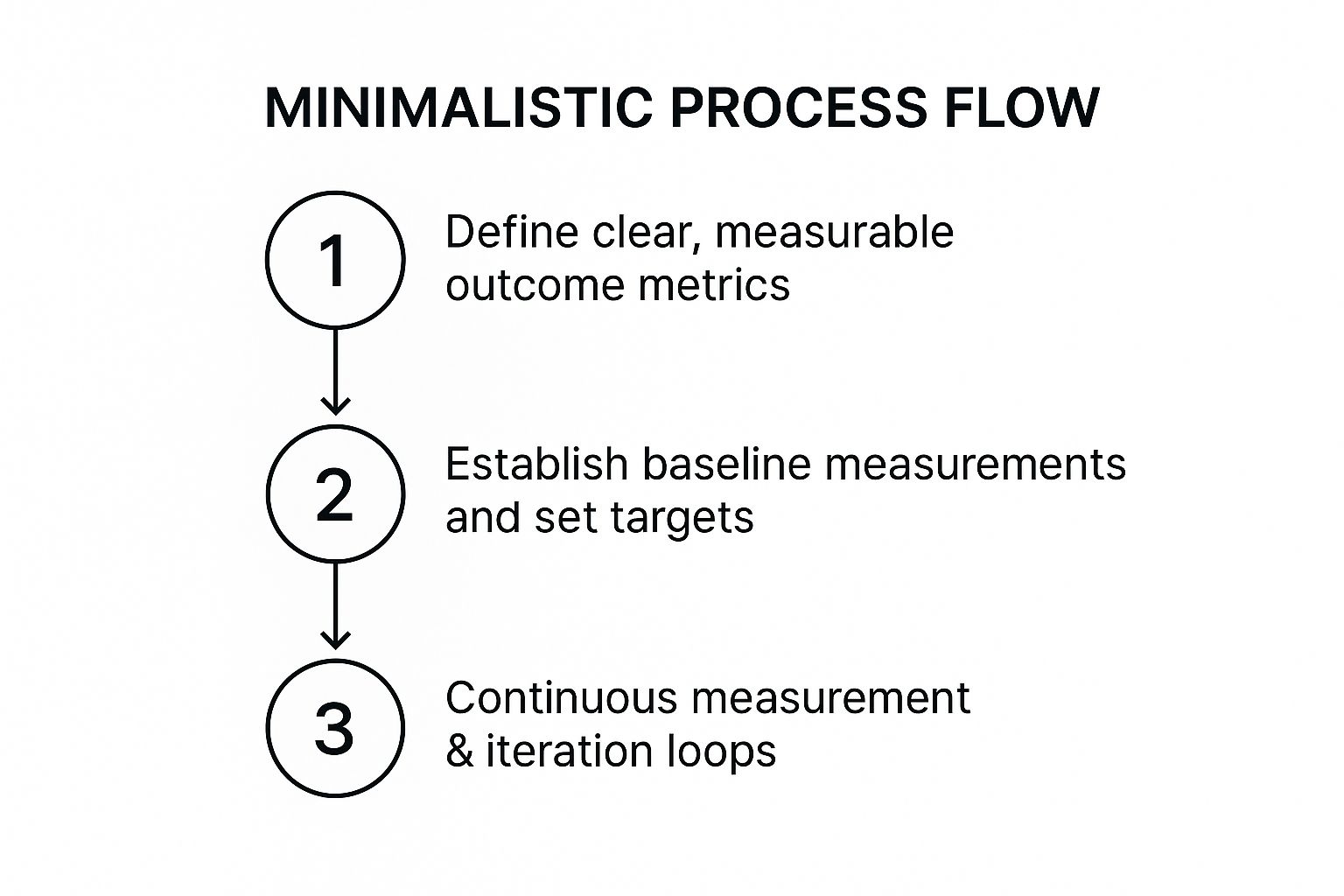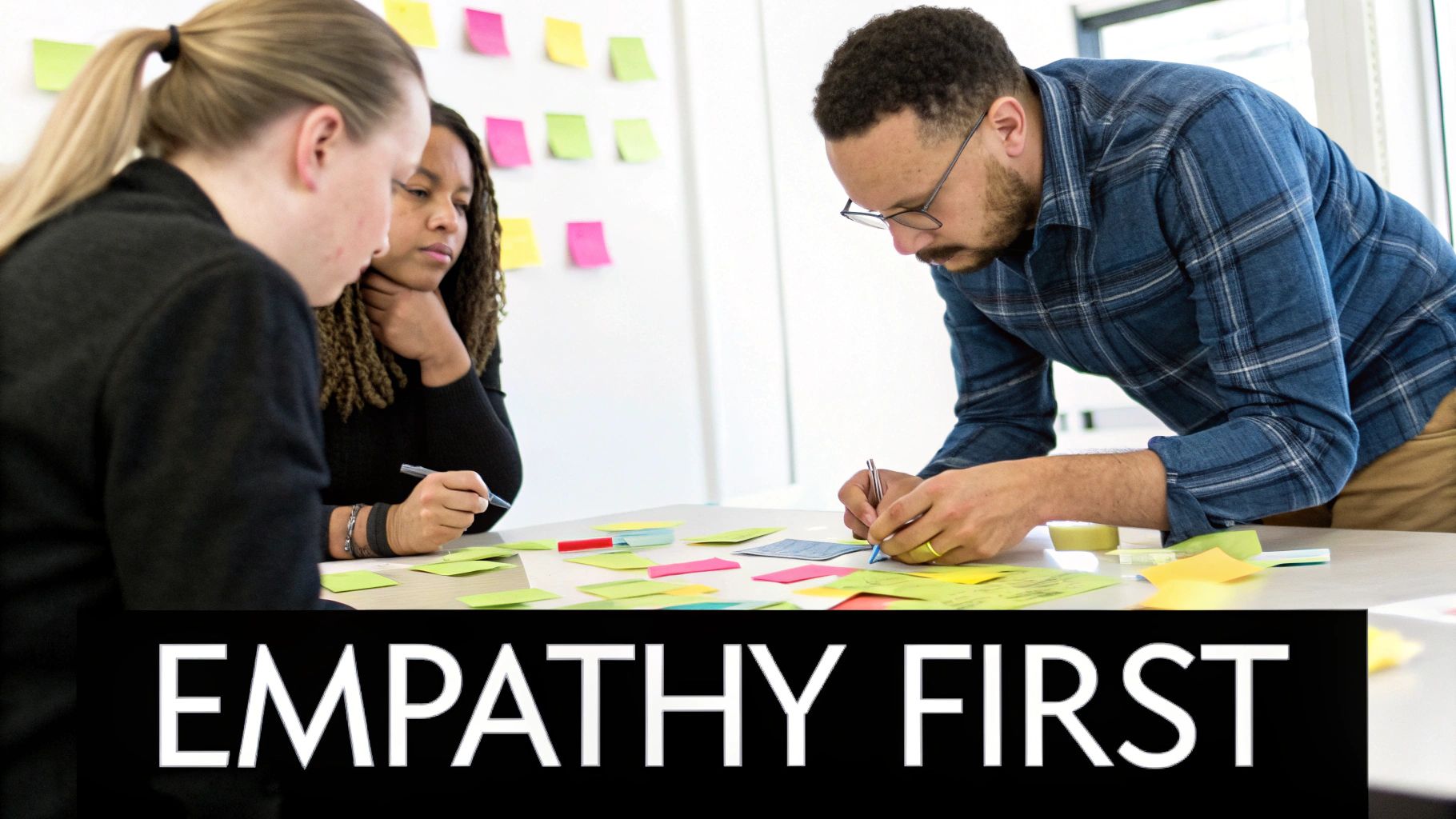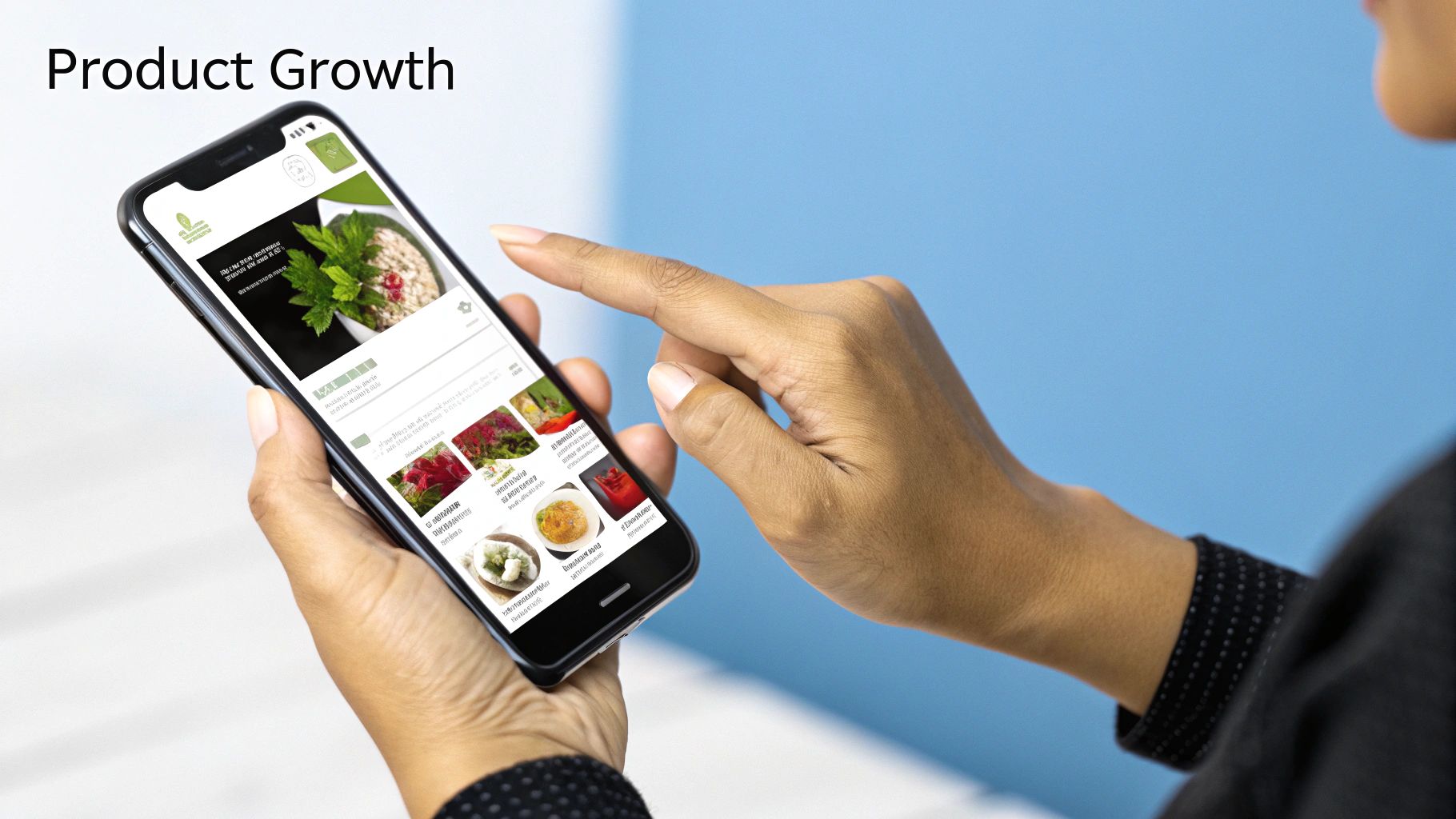10 Product Management Strategies to Drive Growth in 2025
Discover 10 actionable product management strategies to enhance prioritization, reduce churn, and drive growth. Master JTBD, PLG, and more.

In today's hyper-competitive market, simply shipping features is no longer a viable path to success. The most impactful products are built on a foundation of deliberate, customer-centric product management strategies that align teams, mitigate risk, and create undeniable value. Moving beyond reactive roadmapping to proactive strategy is the key differentiator between products that thrive and those that merely survive.
This article unpacks ten powerful frameworks that modern product leaders use to navigate complexity and drive sustainable growth. We will move past high-level theory and dive straight into actionable methods for deeply understanding user needs, aligning entire organizations around meaningful outcomes, and making smarter, data-informed decisions. You will learn not just what these strategies are, but how to implement them effectively within your own teams.
Critically, we will also highlight how AI-driven platforms are revolutionizing these approaches. By transforming qualitative feedback from sources like support tickets, user interviews, and sales calls into quantifiable, revenue-driving insights, these tools provide a new level of clarity. For instance, an AI-powered platform like SigOS can automatically surface patterns that directly correlate with churn risk or expansion opportunities. This empowers product teams to prioritize with unprecedented accuracy, ensuring every development cycle directly impacts the bottom line and strengthens customer loyalty. This guide is your blueprint for building products that win.
1. Jobs to Be Done (JTBD) Framework
The Jobs to Be Done (JTBD) framework is one of the most transformative product management strategies because it shifts the focus from building features to solving fundamental human needs. Popularized by innovators like Clayton Christensen, this approach operates on a simple premise: customers "hire" a product to do a specific "job." This job is the progress a person is trying to make in a given circumstance, encompassing their functional, social, and emotional needs.

Instead of asking what features users want, JTBD forces you to ask why they are seeking a solution in the first place. For example, people don't buy a quarter-inch drill bit; they buy a quarter-inch hole. Netflix understood its customers' job wasn't just to "watch movies" but to "escape and be entertained effortlessly." This insight led them to create a seamless, on-demand experience that outcompeted Blockbuster, whose business model was built around the logistics of physical rentals, not the core job of entertainment.
How to Implement the JTBD Framework
To apply this strategy, product teams must move beyond surface-level feedback and dig into the underlying motivations driving user behavior.
- Conduct "Switch" Interviews: Talk to customers who recently switched to or from your product. Focus on the timeline of their decision, the struggles that prompted the change, and the outcomes they hoped to achieve. This reveals the real "job" they hired your product to do.
- Map the Job, Not the Product: Document the entire process a customer goes through to get their job done, from the initial trigger to the final outcome. Identify every pain point, workaround, and moment of frustration.
- Identify Your True Competitors: With JTBD, your competition isn't just similar products. It's any solution a customer might use to get the job done. For a SaaS project management tool, competitors could include spreadsheets, sticky notes, or even a detailed email thread.
2. Outcome-Based Product Management
Outcome-Based Product Management is a powerful strategy that shifts the team's focus from output (shipping features) to outcomes (achieving valuable results). Popularized by thought leaders like Josh Seiden and Jeff Gothelf, this methodology measures success by the tangible impact a product has on customer behavior and business goals. Instead of a roadmap filled with features, the team rallies around specific, measurable outcomes.

This approach reframes the fundamental question from "What are we building?" to "What change are we trying to create?" For example, Spotify doesn't just measure the number of new playlisting features released; it focuses on outcomes like increasing daily active users or time spent listening. This ensures every initiative is directly tied to creating value, preventing the team from building a feature-rich product that nobody uses. The infographic above illustrates the simple, repeatable process for implementing this strategy. This disciplined, cyclical approach ensures that all development effort is aligned with measurable goals and subject to continuous improvement.
How to Implement Outcome-Based Product Management
Applying this strategy requires a disciplined approach to defining, measuring, and acting on key metrics. It empowers teams to solve problems creatively rather than just executing a predetermined feature list.
- Define Clear, Measurable Outcome Metrics: Before starting any initiative, define what success looks like in terms of a change in user behavior. Instead of "build a new dashboard," the goal becomes "increase user engagement with key reports by 15%."
- Establish Baselines and Targets: Measure the current state of your outcome metric to establish a baseline. From there, set a realistic but ambitious target that the team can work toward.
- Create Continuous Feedback Loops: Regularly track progress against your target outcome. Use this data to inform decisions, validate hypotheses, and pivot your approach when necessary. This turns product development into a continuous learning cycle.
3. Design Thinking for Product Management
Design Thinking is a human-centered product management strategy that prioritizes empathy to solve complex problems. Popularized by innovators like IDEO's Tim Brown and the Stanford d.school, this iterative process integrates user needs, technological possibilities, and business viability. It frames problem-solving through the user's lens, ensuring that the final product is not only functional but also deeply desirable and intuitive.

This approach encourages teams to move beyond assumptions and immerse themselves in the user's world. For example, Airbnb famously used design thinking to save its struggling business. By creating detailed customer journey maps and even visiting hosts' homes, they discovered that poor-quality photos were a major friction point. This empathetic insight led them to invest in professional photography, a solution that dramatically improved listings and rebuilt trust, fueling their explosive growth.
How to Implement Design Thinking
Applying this strategy requires a structured yet flexible process focused on continuous learning and iteration, typically following five key stages: Empathize, Define, Ideate, Prototype, and Test.
- Empathize and Define: Begin with extensive user research, such as interviews and observation, to gain a deep understanding of user pain points. Use this data to craft a clear problem statement from the user's perspective.
- Ideate with Diverse Teams: Bring together stakeholders from different departments (engineering, marketing, support) for brainstorming sessions. The goal is to generate a wide range of potential solutions without initial judgment.
- Prototype and Test Rapidly: Create low-fidelity prototypes like wireframes or clickable mockups to test core ideas with real users. This early feedback loop is crucial for validating concepts and making adjustments before committing significant development resources.
4. Product-Led Growth (PLG)
Product-Led Growth (PLG) is a powerful business methodology where the product itself serves as the primary driver of user acquisition, conversion, and expansion. Unlike traditional sales-led models, which rely on sales teams to educate and close deals, PLG strategies center on creating an intuitive, valuable product experience that encourages users to adopt and advocate for it organically. The core principle is that the best way to sell a product is to let customers experience its value firsthand.

This approach has been championed by companies like Slack, Zoom, and Canva. Slack grew virally as users invited their colleagues into a workspace, demonstrating the product's value with each new team member. Similarly, Zoom's frictionless freemium model allowed individuals to adopt it for meetings, which then spread rapidly within organizations, leading to enterprise-wide adoption. The product experience sells itself, making it one of the most scalable product management strategies available.
How to Implement a PLG Strategy
Implementing PLG requires a deep focus on user experience and a seamless journey from initial contact to paid conversion, all within the product.
- Optimize Time-to-Value (TTV): Design an onboarding process that guides users to their "aha!" moment as quickly as possible. Eliminate friction, provide contextual guidance, and help them achieve a meaningful outcome during their first session.
- Build in Viral Mechanisms: Integrate features that naturally encourage sharing and collaboration. This could be Dropbox's referral program that rewards users with more storage or Canva's team-based design features that prompt invitations.
- Create Clear Upgrade Paths: Use product analytics to understand user behavior and identify triggers for conversion. Present clear, compelling reasons to upgrade from a free or trial version to a paid plan at the exact moment a user needs more advanced functionality.
5. Continuous Discovery Habits
Continuous Discovery Habits, a concept championed by product discovery coach Teresa Torres, represents a fundamental shift from project-based research to an ongoing, sustainable practice of learning. This strategy moves product teams away from sporadic, big-bang research initiatives and embeds weekly customer touchpoints directly into the product development rhythm. The core idea is to make customer-centric decision-making a consistent, ingrained habit rather than an occasional event.
This approach ensures that the team continuously builds and refines a deep, shared understanding of customer needs, pain points, and desires. For instance, teams at Microsoft regularly integrate user feedback into the development of Office products, using insights from ongoing interactions to prioritize features and usability improvements. Similarly, Spotify constantly refines its playlist and discovery algorithms based on a continuous stream of user behavior data and direct feedback, keeping the product closely aligned with listener preferences.
How to Implement Continuous Discovery Habits
Adopting this product management strategy requires a commitment to consistent, small-scale research activities that inform daily and weekly decisions.
- Schedule Weekly Customer Touchpoints: Block out time every week for direct customer interaction, such as interviews or usability tests. Make this time non-negotiable for the product manager, designer, and lead engineer.
- Create Opportunity Solution Trees: Use a visual framework like an Opportunity Solution Tree to map a desired outcome to potential customer opportunities (needs, pain points) and then to possible solutions. This connects every idea back to a validated customer need.
- Share Insights Broadly and Regularly: Create a simple, consistent method for sharing what you learn with the entire team and key stakeholders. This could be a weekly email summary, a dedicated Slack channel, or a brief presentation. The goal is to build a collective understanding of the customer.
6. Platform Strategy
A platform strategy is a powerful business model that creates value by facilitating exchanges between two or more interdependent groups, often producers and consumers. Instead of creating and selling a standalone product, platform product management focuses on building an ecosystem. The platform itself becomes more valuable as more participants join, creating powerful network effects that are difficult for competitors to replicate.
This approach shifts the product manager's role from building features for a single user type to orchestrating a multi-sided market. For example, Uber doesn't own cars; it connects riders with drivers. Apple's iOS doesn't just serve iPhone users; it provides a massive marketplace for developers to reach those users. The value is not in the product alone but in the network it enables, making it a formidable product management strategy for achieving scale and defensibility.
How to Implement a Platform Strategy
Successfully launching and scaling a platform requires a delicate balance of attracting different user groups and establishing rules that benefit everyone.
- Solve the "Chicken-and-Egg" Problem: A platform is useless without both producers and consumers. Decide which side to subsidize or attract first. For example, a new marketplace might offer free listings or bonuses to sellers to build initial inventory before marketing to buyers.
- Invest in Developer/Producer Tools: Make it incredibly easy for producers to create value on your platform. Shopify’s success is heavily tied to its robust APIs, app store, and extensive documentation that empower developers to build solutions for merchants.
- Establish Governance and Trust: Create clear rules, quality standards, and moderation policies early on. A platform’s health depends on the trust between its participants. Airbnb’s review system and host guarantees were critical for building user confidence.
7. North Star Framework
The North Star Framework is a powerful product management strategy designed to align an entire organization around a single, crucial metric. This North Star Metric (NSM) represents the core value your product delivers to customers. Popularized by growth leaders like Sean Ellis and adopted by companies like Amplitude, this framework ensures that every team, from engineering to marketing, moves in the same direction, prioritizing work that directly contributes to customer value and long-term business growth.
Instead of getting lost in competing departmental goals (e.g., marketing wants sign-ups, sales wants demos), the NSM provides a single point of focus. For example, Airbnb’s NSM isn't just revenue; it's "nights booked." This metric perfectly captures the moment value is created for both hosts and guests, reflecting a healthy, growing marketplace. Similarly, Spotify focuses on "time spent listening," which directly correlates with user engagement and their perception of the service's value.
How to Implement the North Star Framework
Applying this strategy requires carefully selecting a metric that truly reflects customer success and then deconstructing it into actionable inputs.
- Choose a Metric That Reflects Customer Value: Your NSM should represent the "aha" moment for your users. It must lead to revenue, reflect user engagement, and measure real progress. For a SaaS collaboration tool, it might be "Weekly Active Teams" rather than individual user logins.
- Identify and Measure Key Input Metrics: The North Star is a lagging indicator. Identify 2-4 key input metrics that directly influence it. For Airbnb's "nights booked," inputs could include the number of listings, search-to-booking conversion rate, and host acceptance rate. Teams can then own and improve these specific inputs.
- Communicate the North Star Relentlessly: The framework's success depends on company-wide adoption. Articulate why the metric was chosen and how every team's work contributes to moving it. Weave the NSM into all-hands meetings, team dashboards, and strategic planning sessions.
8. Dual-Track Agile
Dual-Track Agile is a powerful product management strategy that addresses a common tension in development: the need to build the right thing versus the need to build the thing right. Popularized by thought leaders like Marty Cagan and Jeff Patton, this approach separates product development into two parallel, continuous tracks: Discovery and Delivery. The Discovery track focuses on rapidly exploring and validating ideas, while the Delivery track focuses on building and shipping high-quality, production-ready code.
This parallel process ensures that the development team is always working on features that have been vetted and de-risked. Instead of a linear, waterfall-like handoff from research to development, Dual-Track Agile creates a continuous feedback loop. For example, while the Delivery team is building a validated feature from last week's discovery cycle, the Discovery team is already testing prototypes and interviewing users to decide what to build next. This prevents the engineering team from wasting time on features that don't solve real customer problems.
How to Implement Dual-Track Agile
Applying this strategy requires a dedicated effort to both explore and execute simultaneously, creating a truly agile and customer-centric workflow.
- Dedicate Resources to Discovery: The Discovery track is not a part-time job. It requires a dedicated team, typically including a product manager, a designer, and a tech lead, who focus on generating and validating ideas through user interviews, prototyping, and usability testing.
- Keep Discovery Work Small and Fast: The goal of discovery is learning, not building a perfect product. Use low-fidelity prototypes, A/B tests, and quick feedback cycles to validate or invalidate assumptions quickly and cheaply.
- Involve Engineers in Discovery: To ensure a smooth transition from idea to execution, involve developers from the Delivery track in discovery activities. This gives them context, improves the feasibility of proposed solutions, and fosters a shared sense of ownership.
- Establish a Clear Handoff: Create a well-defined process for moving validated ideas from the Discovery backlog to the Delivery backlog. The idea should be clearly defined, with the core problem, target user, and success metrics understood before development begins.
9. Feature Flag Strategy
A Feature Flag Strategy is a powerful product management technique that decouples code deployment from feature release, giving teams precise control over who sees new functionality and when. Popularized by tech giants like Facebook and Netflix, this approach uses "flags" or toggles in the code to turn features on or off for specific user segments without requiring a new deployment. This enables safer, more strategic rollouts and transforms how products are tested and launched.
Instead of a high-risk "big bang" release, feature flags allow you to gradually introduce a new feature to a small percentage of users, monitor its performance, and address any issues before a full-scale launch. For instance, LinkedIn uses feature flags to test new profile enhancements with specific user types, like "recruiters" or "job seekers," to gather targeted feedback. This methodology minimizes risk, facilitates continuous delivery, and empowers data-driven decision-making.
How to Implement a Feature Flag Strategy
To effectively leverage this strategy, product teams need to integrate feature flags into their development and release lifecycle with clear governance.
- Establish a Flag Management System: Use a dedicated platform like LaunchDarkly or build an in-house tool to manage flags. This system should allow for easy toggling, user segmentation, and performance monitoring.
- Define Clear Rollout Plans: Before enabling a flag, create a plan that outlines the target audience (e.g., internal teams, beta testers, 5% of new users), success metrics, and a rollback trigger.
- Implement Flag Lifecycle Management: Create a process for cleaning up old flags. Flags that are fully rolled out and stable should be removed from the codebase to prevent technical debt and complexity.
- Integrate with Analytics: Connect your feature flags to analytics tools to measure the impact of the new feature on user behavior, conversion rates, and system performance. This enables robust A/B testing and quantitative validation.
10. Value Proposition Design
Value Proposition Design is a foundational product management strategy that provides a systematic framework for creating products customers actually want. Developed by Alexander Osterwalder and Yves Pigneur, this approach ensures a deep and explicit connection between your product's features and the customer's true needs. It moves beyond guesswork by mapping customer jobs, pains, and gains directly to your solution's value-creating elements.
This strategy operates on a core principle: great products don't just have useful features; they are designed to be essential solutions to pressing problems or aspirations. For example, Slack’s value proposition isn't merely "a messaging app." It's an organized, searchable hub for team communication that reduces inbox clutter (a pain), integrates with other tools (a gain), and makes collaboration faster (a job). By focusing intently on these elements, Slack created a solution that felt indispensable to its target users.
How to Implement Value Proposition Design
To apply this strategy, product teams use the Value Proposition Canvas, a visual tool that helps align what you're building with what customers value.
- Map the Customer Profile: Begin by deeply understanding your customer segment. Document their "Jobs" (what they're trying to get done), "Pains" (the obstacles and negative outcomes they face), and "Gains" (the desired benefits and outcomes).
- Design the Value Map: On the other side of the canvas, detail your "Products & Services." Then, specify how they act as "Pain Relievers" that address the identified pains and "Gain Creators" that deliver the desired gains.
- Achieve a Strong Fit: The goal is to create a clear fit between the two sides. Your pain relievers and gain creators should directly correspond to the most significant pains and gains of your customer profile. If they don't, it’s a sign of a weak value proposition.
10 Product Management Strategies Comparison
| Framework / Strategy | Implementation Complexity 🔄 | Resource Requirements 🔄 | Expected Outcomes 📊 | Ideal Use Cases 💡 | Key Advantages ⭐ |
|---|---|---|---|---|---|
| Jobs to Be Done (JTBD) | Medium to High 🔄🔄 | High (customer research intensive) 🔄 | Identify unmet needs; customer-centricity 📊 | Product positioning, innovation discovery 💡 | Reveals true customer motivations; competitive advantage ⭐ |
| Outcome-Based Product Management | Medium 🔄 | Medium to High 🔄 | Improved business impact; aligned teams 📊 | Teams focused on value delivery and outcomes 💡 | Aligns teams around value; reduces feature bloat ⭐ |
| Design Thinking for Product Management | Medium to High 🔄🔄 | Medium to High 🔄 | Deep user empathy; innovative solutions 📊 | Complex problems requiring creativity and empathy 💡 | Encourages creativity and rapid prototyping ⭐ |
| Product-Led Growth (PLG) | High 🔄🔄 | High (product development focus) ⚡ | Scalable growth driven by product 📊 | SaaS, self-serve, freemium models 💡 | Low CAC; viral growth; user-driven adoption ⭐ |
| Continuous Discovery Habits | Medium 🔄 | Medium (regular customer touchpoints) 🔄 | Faster learning cycles; reduced risk 📊 | Teams wanting ongoing customer insights 💡 | Maintains customer connection; improves confidence ⭐ |
| Platform Strategy | High 🔄🔄 | Very High 🔄 | Scalable network effects; ecosystem growth 📊 | Multi-sided markets; ecosystem building 💡 | Strong moats; leverages external innovation ⭐ |
| North Star Framework | Low to Medium 🔄 | Low to Medium 🔄 | Clear focus and alignment on key metric 📊 | Organizations needing unified product focus 💡 | Simplifies decision-making; enhances accountability ⭐ |
| Dual-Track Agile | Medium 🔄 | Medium (discovery & delivery teams) 🔄 | Balanced speed & validation; reduced risk 📊 | Agile teams balancing discovery and delivery 💡 | Maintains velocity and learning; evidence-based ⭐ |
| Feature Flag Strategy | Medium 🔄 | Medium to High 🔄 (tools & management) | Safer releases; targeted experimentation 📊 | Teams needing gradual rollouts and A/B testing 💡 | Reduces deployment risk; supports testing and personalization ⭐ |
| Value Proposition Design | Medium 🔄 | Medium (customer research + mapping) 🔄 | Strong product-market fit; clear value 📊 | Defining and validating customer value creation 💡 | Visual tools for alignment; guides prioritization ⭐ |
Integrating Strategies for Maximum Impact
Navigating the complex world of product development requires more than just a single playbook. The ten powerful product management strategies we've explored, from the customer-centric Jobs to Be Done framework to the agile execution of Dual-Track Agile, are not isolated tactics. Their true potential is unlocked when they are woven together into a cohesive, interconnected system that places customer value and business outcomes at its core.
Imagine a product team that doesn't just adopt Continuous Discovery but uses its findings to refine their Value Proposition Design. The insights gained from direct customer interaction directly inform how they articulate value, ensuring marketing messages and product features are perfectly aligned with user needs. This powerful combination provides a clear, validated direction for what to build next.
Creating a Strategic Flywheel
The synergy between these approaches creates a powerful flywheel effect. For instance:
- JTBD meets North Star: The Jobs to Be Done framework helps you understand the fundamental "job" your customer is hiring your product to do. This deep understanding is the perfect foundation for defining a meaningful North Star metric that accurately reflects the value customers receive.
- PLG powered by Feature Flags: A Product-Led Growth strategy relies on delivering value upfront and letting the product drive acquisition and retention. A sophisticated Feature Flag strategy is the engine that powers this, allowing you to test new user onboarding flows, experiment with freemium features, and roll out changes incrementally to specific user segments, all without high-risk, big-bang releases.
- Outcome-Based goals with Dual-Track Agile: Outcome-Based Product Management sets the "what" and "why" by focusing on desired changes in user behavior. Dual-Track Agile provides the "how," creating a parallel process where discovery work continuously informs a streamlined and efficient delivery track, ensuring you're not just building features efficiently but building the right features that move the needle on key outcomes.
This integrated approach shifts the focus from a feature factory mindset to one of continuous, evidence-based value creation. Each strategy reinforces the others, creating a robust framework for making smarter, more impactful decisions.
The Missing Link: Quantifying Qualitative Data
A common thread running through all these advanced product management strategies is the critical need for high-quality, objective customer insights. Your roadmap should be a direct reflection of what solves the biggest customer problems and creates the most significant business value. Yet, the most valuable data is often trapped in unstructured, qualitative formats like support tickets, sales call transcripts, and customer feedback surveys.
Manually sifting through this mountain of data is not just inefficient; it's prone to bias and guesswork. This is the critical gap where modern tools become a strategic imperative. The ability to automatically analyze this qualitative feedback and, more importantly, quantify its direct impact on revenue and churn is a game-changer. It transforms anecdotal evidence into a prioritized, actionable roadmap backed by hard data.
By leveraging AI to connect customer pain points directly to business metrics, you can confidently answer the most important questions: Which bug fixes will prevent the most churn? Which feature requests are tied to the largest expansion opportunities? This objective data empowers you to execute on these product management strategies with precision and authority, ensuring your team’s efforts are always focused on what matters most. The future of product management is not just about adopting a new framework; it's about fueling that framework with intelligent, data-driven insights to build products that customers truly value and your business can count on.
Ready to stop guessing and start quantifying the revenue impact of your product decisions? See how SigOS uses AI to analyze customer feedback and automatically prioritize your roadmap based on what truly drives growth and reduces churn. Explore the platform at SigOS.


